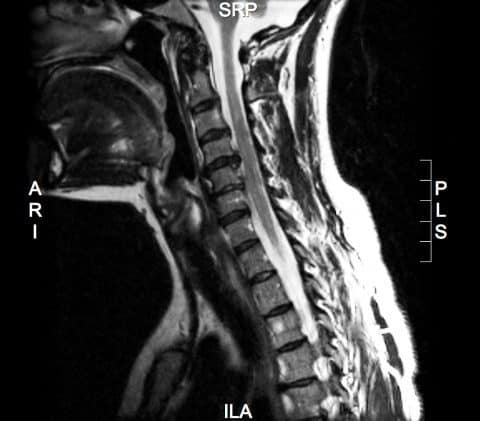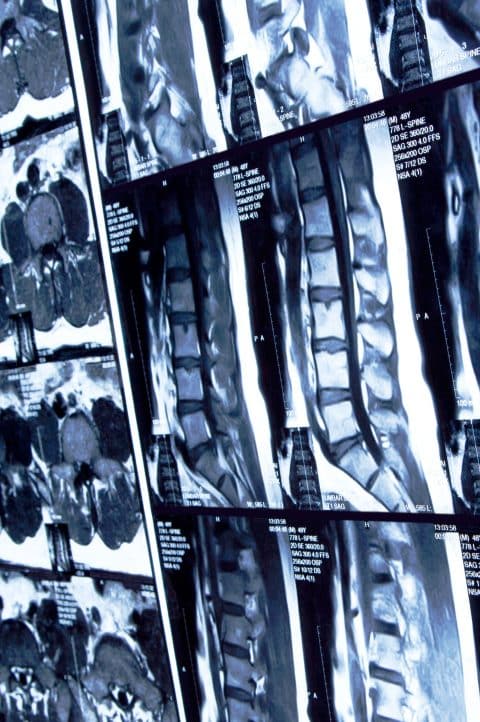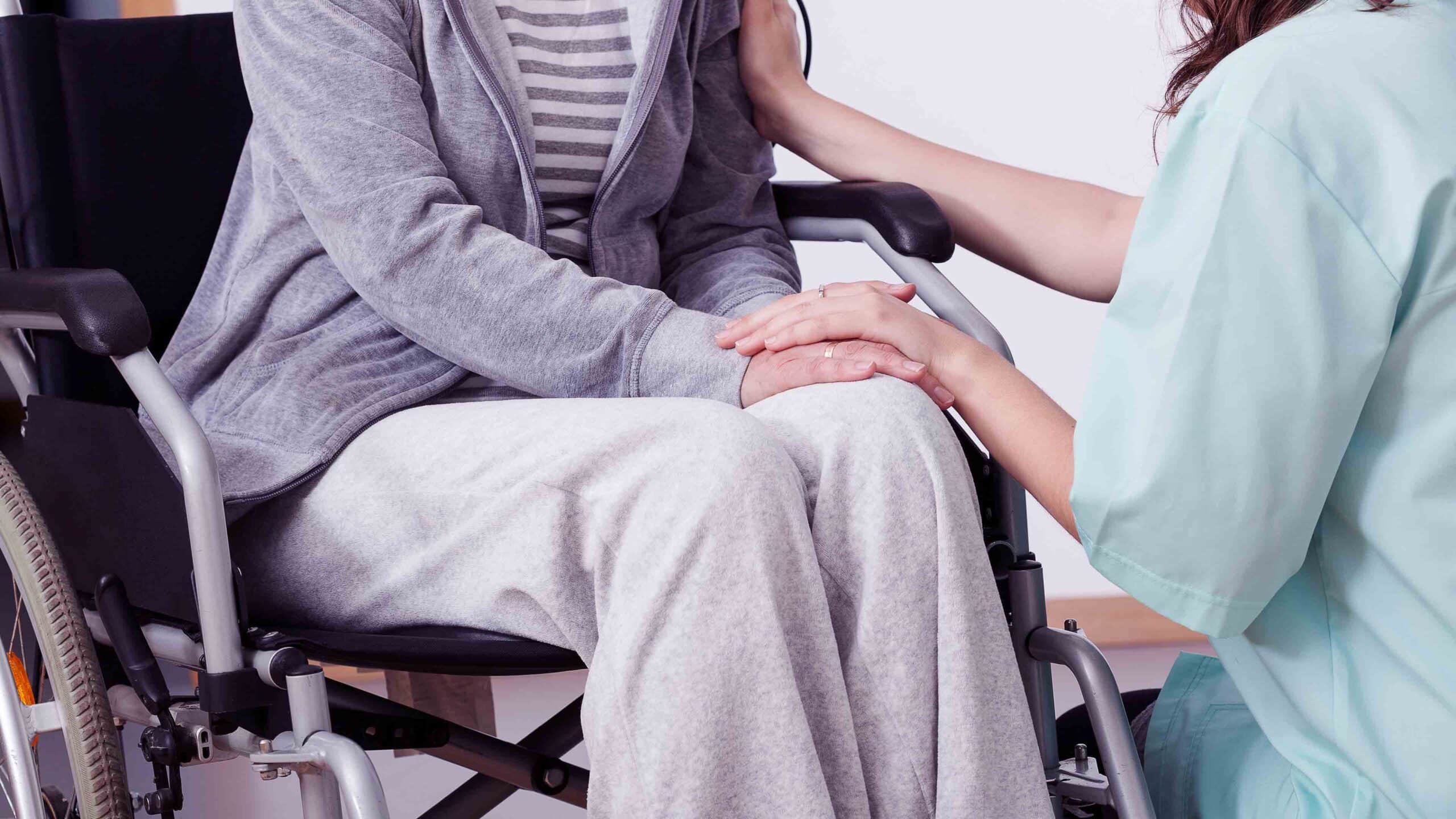A 2016 study, looking at data from 2013, estimated nearly 5.4 million Americans were living with some form of paralysis. Researchers identified strokes and spinal cord injuries as the two main causes, accounting for a total of 61% of the cases of paralysis in the U.S.(3) In some cases, medical or surgical complications can cause spinal cord injuries that result in paralysis.(4) (5)
Strokes Are the Leading Cause of Paralysis
Researchers have found strokes to be the leading cause of paralysis in the U.S., accounting for almost 34% of all cases.(6) Paralysis from stroke may affect only one side of the body (hemiplegia) or may be localized in the face, an arm, or a leg.(7)
A stroke is the result of the brain being suddenly deprived of oxygen, either by a blockage or a burst blood vessel. Brain cells in the affected area die quickly.(8) This includes neurons, specialized brain cells that send messages to muscles and other cells. Research estimates the “typical patient loses 1.9 million neurons each minute in which stroke is untreated.”(9)
Have you or a loved one suffered paralysis as a result of a stroke misdiagnosis? Contact us today.
Get a Free Case ReviewIn a 2012 study of misdiagnosis of neurological emergencies including stroke, the authors wrote, “Misdiagnosis contributes to medical malpractice in the ED and patient harm.”
When treating a stroke, every second counts, but strokes can often be misdiagnosed, wasting precious time. Studies have put the rate of hospital emergency department (ED) misdiagnosis of stroke and mini-stroke (TIA) from “as low as 2% to as high as 56%.” In a 2012 study of misdiagnosis of neurological emergencies including stroke, the authors wrote, “Misdiagnosis contributes to medical malpractice in the ED and patient harm.”(10)
If you suffered paralysis as a result of a stroke that was misdiagnosed, delaying proper treatment, you may benefit from talking to an attorney. Weitz & Luxenberg’s Personal Injury and Malpractice Group can help you determine if you should seek compensation for your injuries.
Spinal Cord Injuries Are a Leading Cause of Paralysis
The 2016 study mentioned earlier found spinal cord injuries were responsible for more than 27% of paralysis cases in the U.S. — second only to strokes.(11)
The National Spinal Cord Injury Statistical Center estimates there are 12,000 new spinal cord injury cases every year in the U.S. The center reported that from 2010 through 2014, the three leading causes of spinal cord injuries, in order, were:(12) (13)
- Vehicle crashes (38%)
- Falls (30%)
- Acts of violence (such as gunshot wounds or assault) (14%)
- Other
Spinal cord injuries can also be caused by industrial accidents.(14) All of these are incidents where negligence or other wrongdoing toward the victim may have been involved.
If you have suffered a spinal cord injury as a result of someone’s negligence, you may be entitled to compensation. Weitz & Luxenberg provides a free consultation to help you determine your legal options.
How Do Spinal Cord Injuries Cause Paralysis?

The spinal cord is a bundle of nerves that runs down the neck and back, through the spine, carrying signals between the body and brain. Spinal cord injuries are most often the result of vertebrae being fractured or dislocated by some physically traumatic event causing damage to the nerves.(15)
The spinal cord does not have to be severed to cause paralysis. A loss of muscle function can occur from bruising, crushing, or stretching the spinal cord. The terms “complete” or “incomplete” are used to describe the level of injury in a spinal cord injury.(16)
An incomplete spinal cord injury occurs when the spinal cord is partially injured and some sensation and movement are still possible below the injury. A complete spinal cord injury occurs when the cord is severed. In a complete spinal cord injury, the cord can no longer carry signals below the point where it is damaged. This leaves a person paralyzed below that point.(17)
Different Spinal Cord Injuries Can Cause Different Kinds of Paralysis
The spinal cord consists of four regions — cervical, thoracic, lumbar, and sacral. Each of these regions is further categorized based on their position along the 33 vertebrae that make up the spine. Each region connects to different parts of the body and the extent of injuries can vary depending on the site of the injury:(18) (19)
Cervical Region
The eight segments in the neck connect the brain with the arms and sometimes the diaphragm. A spinal cord injury here can result in quadriplegia and can include paralysis of breathing muscles.
Thoracic Region
The 12 segments in the upper back control signals to and from the upper torso and parts of the arm. Injuries at chest level can cause paralysis of the legs and lower body.
Lumbar Region
The five segments in the mid-back control signals to the hips and legs.
Sacral Region
The five segments below the lumbar region control signals to parts of the legs, the toes, and the groin. A spinal cord injury in either the lumbar or sacral regions can affect one or both legs and muscles that control the bladder and bowels.
Generally, the closer the injury is to the brain, the higher its level of severity. In addition to losing motor control of muscles below the injury point, organs below that point may no longer function as they did before the injury.(20)
What Are the Symptoms of a Spinal Cord Injury?
Spinal cord injuries are medical emergencies and require immediate treatment. Symptoms of a spinal cord injury can vary and may include:(21)
- Loss of feeling at and below the injury
- Increased muscle tone (spasticity)
- Loss of bladder and bowel control
- Pain
- Numbness
- Weakness or paralysis
- Sensory changes
If the spinal cord injury occurs in the neck, symptoms may affect arms, legs, and, if it is high up in the neck, the muscles necessary for breathing. If the spinal cord injury happens at chest level, the victim may experience blood pressure problems, abnormal sweating, or trouble maintaining normal body temperature.(22)
How Are Spinal Cord Injuries Diagnosed?
Spinal cord injuries are not always recognizable. A person should be assessed after experiencing any of these injuries:(23)
- Head injuries, especially if there is trauma to the face
- Penetrating injuries near the spine
- Injuries from falls
- Pelvic fractures
If a person has experienced any of the symptoms mentioned above after one of these injuries, he or she may have suffered a spinal cord injury. Emergency responders should be called if at all possible. They can immobilize the patient to prevent further damage to the spinal cord and take the person to an emergency room or trauma center.(24)
Once there, doctors and other health care providers will perform a physical exam to determine the exact location of the injury. Further tests may include:(25)
- A CT (CAT) scan
- An MRI to give health care providers “a picture” of the injury
- X-rays, or a myelogram (injecting dye before X-raying the spine)
- Electromyography (or EMG, which checks muscles and the nerves that control them)
How Are Spinal Cord Injuries Treated?
The time between the injury and treatment can affect the outcome. Quick response can lessen the long-term effects of a spinal cord injury.(26)

Treatment may include:(27) (28)
- Medications to reduce inflammation
- Traction to stabilize the spine
- Various types of surgery
Depending on the type of trauma that led to the spinal cord injury, surgery may involve:(29)
- Removing fluid or tissue to reduce pressure
- Removing bone or disc fragments
- Removing foreign objects
- Fusing broken vertebrae
- Implanting spinal braces
The National Spinal Cord Injury Statistical Center estimates the average initial hospital stay for a spinal cord injury is 11 days. Rehabilitation stays average 36 days.(30)
Rehabilitation for a spinal cord injury may include:(31)
- Physical therapy for muscles, communication skills, and mobility
- Learning to use assistive devices, such as wheelchairs or walkers
- Use of communication devices
- Occupational therapy to improve motor skills
- Vocational therapy to help people return to work with assistive devices
If a patient fails to recover movement or feeling in the affected area after six months, loss of function is more likely to be permanent.(32) The National Spinal Cord Injury Statistical Center estimates 30% of people with a spinal cord injury will be rehospitalized one or more times during any given year following the injury, with each stay averaging 22 days.(33)
How Can Medical Procedures Result in Paralysis?
Though rare, paralysis can sometimes result from medical or surgical procedures. The National Spinal Cord Injury Statistical Center estimates these causes accounted for 5% of all spinal cord injuries from 2010 through 2014.(34)
Medical complications leading to spinal cord injuries can include traumatic injuries sustained during surgery near the spine(35), and direct damage to the spinal cord from inserting an anesthetic needle.(36)
Medical or surgical complications are the fourth leading cause of spinal cord injuries among women.(37)
What Are the Costs of Paralysis from a Spinal Cord Injury?
The National Spinal Cord Injury Statistical Center has found quadriplegia (complete or incomplete) accounted for 65% of new paralysis cases resulting from spinal cord injuries between 2010 and 2014.
The center also estimates staggering lifetime health and living expenses for people with quadriplegia. First-year costs alone can range from nearly $770,000 to more than $1 million. Each subsequent year can cost between $113,000 to nearly $185,000. For a 25-year-old, that can add up to as much as $4.7 million over a lifetime. (All amounts from the center are estimated in 2014 dollars).(38)
Another 35% of spinal cord injuries resulted in paraplegia (complete or incomplete) between 2010 and 2014. The center estimates first-year health and living expenses for paraplegia at more than $500,000 with subsequent annual costs of close to $69,000 and lifetime expenses of $2.3 million for a person 25 years old when injured.(39)
Financial Planning Is Crucial If You Suffer Paralysis
While sudden paralysis can greatly increase costs for medical care and living expenses, it can also greatly diminish your ability to work and earn a living. If you suffer paralysis, it is important to consider long-term financial planning. Steps include:
Discussing disability benefits with your employer
Calculating medical expenses
Locating medical, financial, and legal records
Maintaining your insurance coverage
Talking with an attorney
If your injuries are the result of someone else’s negligence, you may be entitled to compensation. Weitz & Luxenberg’s attorneys can help you determine your legal options.
Fighting for Justice When Negligence Leaves a Victim Paralyzed
In November 2016, a New York court awarded $23 million to a music producer paralyzed from the neck down by a hit-and-run driver. After the accident happened, the car’s owner reported it had been stolen.
The injured man turned to Weitz & Luxenberg, whose personal injury team found evidence and witnesses that proved to jurors the car had not been stolen and that the owner’s son had been behind the wheel during the crash.
“The defendant in this case and his son lied in an attempt to get out of paying for our client’s medical bills, pain, and suffering,” associate attorney Adam Raffo with Weitz & Luxenberg’s Personal Injury and Medical Malpractice Group said. “This verdict will force him to address his wrongdoing.”
The verdict awarded the injured man $20.5 million for past and future pain and suffering and another nearly $3 million for medical expenses.
